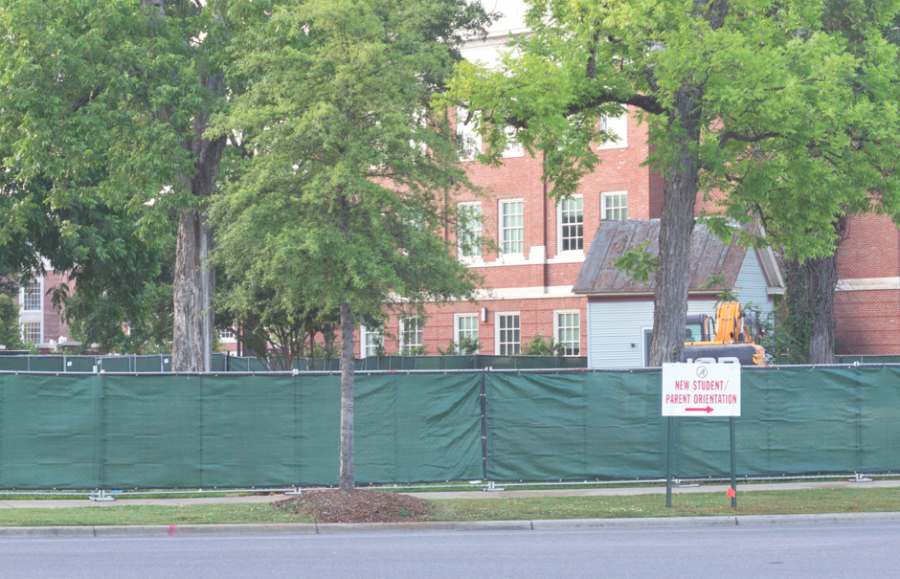In light of the recent destruction of the Kilgore house on the UA campus, many locals, students and preservationists are raising into question what pieces of history can be protected and what can be destroyed to make way for newer, bigger projects.
The Kilgore House is an example of a historic site that, although it was deemed historic, was not offered a great deal of protection from impending demolition.
“The first any of us knew of the impending demolition of the Kilgore House was the erection of a chain-link fence around it a couple of days before it was razed,” said Dr. Robert Mellown, retired professor of art history and architectural historian. “It is regrettable that the University chose to demolish the Kilgore House which was an important part of its own history and that of the [Bryce] hospital.”
The University plans to save the outdoor kitchen or storehouse area of the Kilgore House as part of a new outdoor dining area, which will be part of the new Fresh Foods.
“The University’s intention of ‘saving’ the outdoor kitchen or storehouse shows a complete misunderstanding of the significance of the site,” Mellown said. “The main house, not the outbuilding, had important historical associations with the management of Bryce Hospital and with the history of female education at The University of Alabama.”
Regardless of preservationists, experts and students in the area raising their voices in protest of the inevitable demolition of the Kilgore House, because no buyer came forward to purchase it, the University felt no preservation efforts could save the house because of its size and age.
“The University appreciates the interest and concern of our constituents,” Cathy Andreen, director of media relations for the University, said. “We are pleased that many historic pieces were removed from the house and given to Alabama Heritage Magazine, the University Libraries and the Jemison-Van de Graaff Mansion for preservation.”
Andreen said because of the size and age of the Kilgore House and the way it was originally constructed, it was not feasible to restore it for University use, but Tim Higgins, one of the founders of Preserve Tuscaloosa, said the situation was the exact opposite.
“The house wasn’t old enough,” Higgins said. “It’s not an antebellum. It’s not pre-Civil War.”
Higgins said although the University needs to add new buildings to campus, there are repercussions for tearing down pieces of history such as the Kilgore House.
“Things do need to be updated, and the University does need to change with the times; however, there’s so much history ingrained in what we already have,” Higgins said. “They’re tearing down the sorority houses and all the interior design buildings, and they’re building beige giants and beige monsters.”
But the ability of a seemingly historic building to be saved all depends on its level of historic identification. And if the Tuscaloosa County Preservation Society identifies a building or site as historic, the level of protection for that building may vary further in accordance with what type of structure it is.
The age of the building is a large deciding factor in what weight the building carries, as well as what the building was originally used for, said Katherine Richter, executive director of the Tuscaloosa County Preservation Society.
“It depends on what the house was used for, who lived there, and how vital that person was to the community,” Richter said. “We also take into account what the commercial value is, as well as the building’s role in the community.”
There are two levels of classification of historic buildings: one is honorary, which receives a plaque from the Tuscaloosa County Preservation Society, and the other is recognition from the National Register of Historic Places.
Buildings that receive honorary recognition are 50 years of age or older but receive no special protection from possible demolition. Buildings listed on the National Register of Historic Places offer slightly more protection, but Richter said this distinction does not always protect the structure from being demolished.
“Just because it’s listed on the National Register doesn’t protect it, but it carries a little bit more weight than one of the plaques from the Preservation Society because it’s a more complicated application process,” Richter said. “The larger a list is regionally, statewide or nationally carries more weight than if it’s local because it requires more detail.”
Andreen said a common misconception about the University’s campus is which buildings are classified as historic and which are not.
“UA’s Moundville Archaeological Park has been designated as a National Historic Landmark by the National Park Service,” Andreen said. “A few buildings on campus, including the President’s Mansion and Foster Auditorium, are listed on the National Register of Historic Places. People often refer to buildings that are old, unusual or have some special significance as historic, but that is not an official designation.”
Higgins said he thinks the Capstone has done a good job of restoring 1960s buildings on campus and adding uniformity to them, instead of tearing them down to build a new set of uniform buildings.
“The University makes every effort to maintain, renovate and upgrade buildings on campus,” Andreen said. “For example, Lloyd, Graves, Moore, Little and Russell halls all have undergone major renovations in the last few years. Ten Hoor is currently being renovated as well, and the University has also made a significant investment in restoring the historic Gorgas House.”
Higgins said downtown Tuscaloosa and the city as a whole are losing their sense of place because of the demolition of buildings with historic value, which he has seen firsthand with the city of Tuscaloosa trying to build a five-story tall apartment building next to his block, which he said currently consists of turn-of-the-century housing that has been converted into offices.
The project is what prompted the formation of Preserve Tuscaloosa, which helps Tuscaloosa residents stay abreast to information about preserving the community.
“We started the group to protect our community, and we branched out to protect the Tuscaloosa community as a whole,” Higgins said. “Our purpose is to keep the community informed about historic structures around town, because there’s a lot of things that the University and the city can do without letting people know, under the table.”
Richter said Tuscaloosa went through a period of change during the 1960s where the community lost many of its historic and one-of-a-kind buildings.
“I fully believe in preservation, because the greenest building is a building that is already standing,” Richter said. “Because we’ve already lost so much, there’s a proper way to go about it so that everything is handled in a professional manner.”
Richter said because Tuscaloosa is a community that uses traditions to describe the community as a whole, it is important the traditions of the community are well preserved.
“There’s no better way to explain your tradition than in the physical existence of where that tradition came from,” Richter said.
Higgins said radical actions are what get young people to pay attention to their community, and he’s glad that these actions are receiving attention.
“The University is a progressive entity in the South,” Higgins said. “UA should really be trying to protect its heritage and its culture. This is our heritage – it’s where we came from and where we’re going.”









